The Habsburg lip
Posted by Richard on UTC 2016-04-01 07:28
The magnificent Rudolph I (1218-1291), the first Emperor of the Holy Roman Empire from the House of Habsburg, elevated the family onto the European stage. The Emperor of the Holy Roman Empire was an elected position, but after a few small hiccups the Habsburgs became a major dynasty that claimed that title as its own automatic inheritance for another seven centuries.
After Rudolph, the family – headed at times by quite remarkable people, at times by dimwits – fanned out from Austria across Europe, particularly into Spain. Two centuries or so after Rudolph, the Spanish and Austrian houses were united by another great Habsburger, Karl V (1500-1558), who could correctly boast that the sun never set in his empire, since it now included the Spanish colonies in the New World.

Karl V. At twenty he had the chin, but the painter has cleverly lessened its impact by painting his lips slightly open and reducing the strongly undershot jaw. These court painters knew what they were doing in coping with such challenges.
Bernard van Orley (1491/1492-1542), Portrait of Charles V, Holy Roman Emperor (detail), c. 1519.
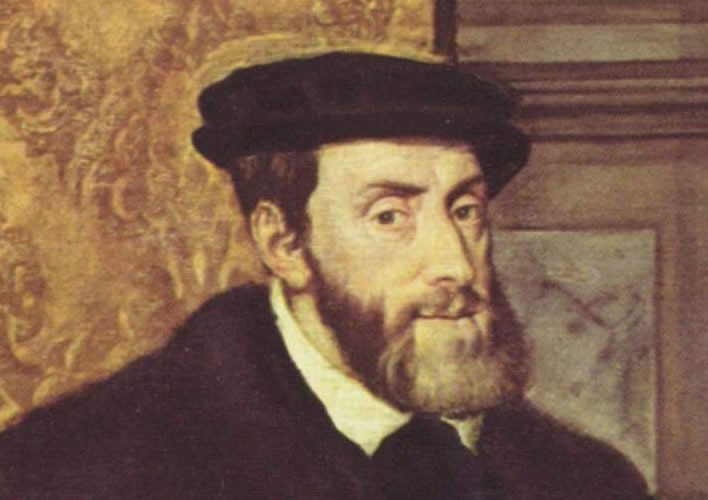
In this painting Karl V is now 48 years old and has covered his chin with a beard.
Lambert Sustris (1515–1591), Portrait of Charles V Seated (detail), 1548.
In portraits of Karl V such as these we cannot fail to be struck by that brand logo of the later Habsburg rulers, the phenomenon known as the 'Habsburg jaw' or 'Habsburg lip'. Karl's grandfather, Emperor Maximilian I (1459-1519) had a receding but nonetheless undershot chin, a facial feature that appears to have jumped over his son Philip I (1478-1506) (the 'Fair') to reappear with renewed vigour in Maximilian's grandson, Karl V.
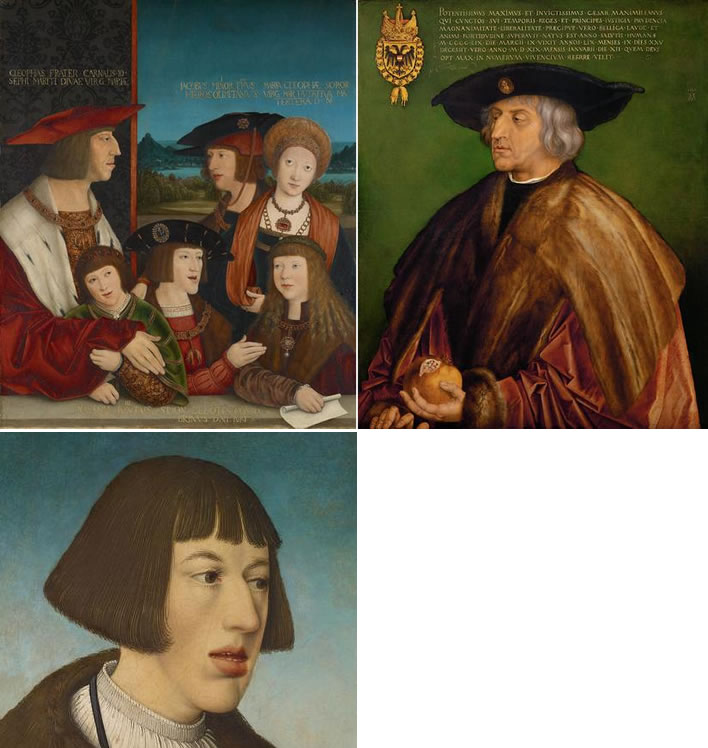
Three portraits of Maximilian I and family members.
The fine portrait at top right is by Albrecht Dürer (1471-1528) and was painted in 1519. It does the Emperor proud, as we might expect with an artist of Durer's quality. Maximilian's chin is treated sensitively, being there, but not there, if you know what I mean.
At top left is an interesting family group, painted sometime after 1515 by Bernhard Strigel (1460-1528). It shows Emperor Maximilian I (1459-1519) on the left, his first wife Maria von Burgund (1457-1482) on the right and between them their son Philip 'the Fair' (1478-1506). At the front, left to right, are Maximilian's grandsons Ferdinand I (1503-1564) and Karl V (1500-1558) and his grandson-in-law Ludwig II (1506-1526). The painting shows us Maximilian's receding but undershot chin and Karl's noticeable monster, even as a child. Unlike Dürer, Strigel appears to have made no attempts at heroic flattery.
Ferdinand's Habsburg chin is just about visible in the group painting: in his adult years it formed fully, as we can see in the painting at the bottom showing us the 18 year-old Ferdinand by Hans Maler (1500?-1529?) in 1521. All images: Kunsthistorisches Museum Wien.
The fact of the Habsburgs' continued success is quite a surprise, given the family's incestuous selection of marriage partners, an inbreeding that we now suspect led to the production of many defective children as well as to the propagation of the Habsburg lip down the generations.[1]
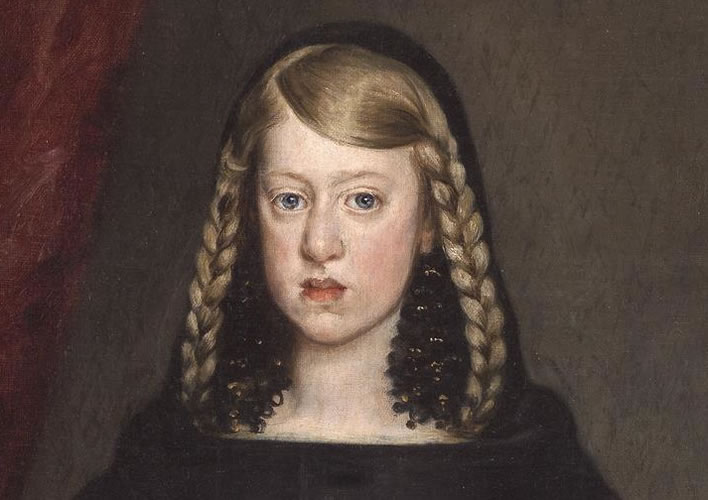
Margarita Teresa of Spain/Austria, in mourning for her father. A year after this painting was made she would marry Leopold I of Austria (see below), another fine pair of Habsburg lips.
Juan Bautista Martínez del Mazo (1611-1667), Doña Margarita of Austria (1651-1673)(detail), c. 1665. Museo del Prado
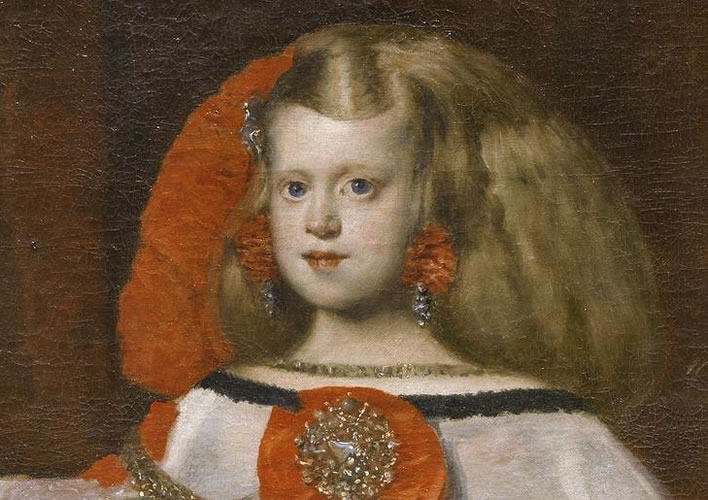
Another painting of Margarita Teresa of Spain/Austria
Juan Bautista Martínez del Mazo (1611-1667), The Infanta Margarita de Austria (1651-1673)(detail), c. 1665. Museo del Prado
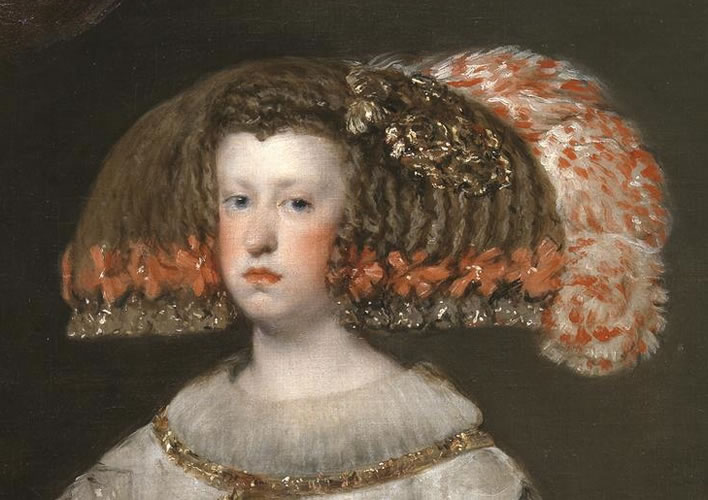
Queen Mariana of Austria (1634-1696), another set of Habsburg genes. She was intended to marry her cousin, but he died and she married another Habsburg, Philip IV.
Diego Rodríguez de Silva y Velázquez (1599-1660), Queen Mariana of Austria (1634-1696)(detail), c. 1652. Museo del Prado
Inbreeding may have brought dynastic success, but it came at a terrible cost. In some members of the family, such as the physically and mentally incapable Carlos II (1661-1700) – 'the Cursed' – of Spain, whose parents were genetically even closer than brother and sister, the entire jaw is massively undershot.
In theory the hereditary monarch is divinely chosen to succeed to the throne. If, as we are told in Cowper's hymn, 'God moves in a mysterious way / His wonders to perform' then we can only say that the choice of Carlos II as King of Spain is mysterious indeed.
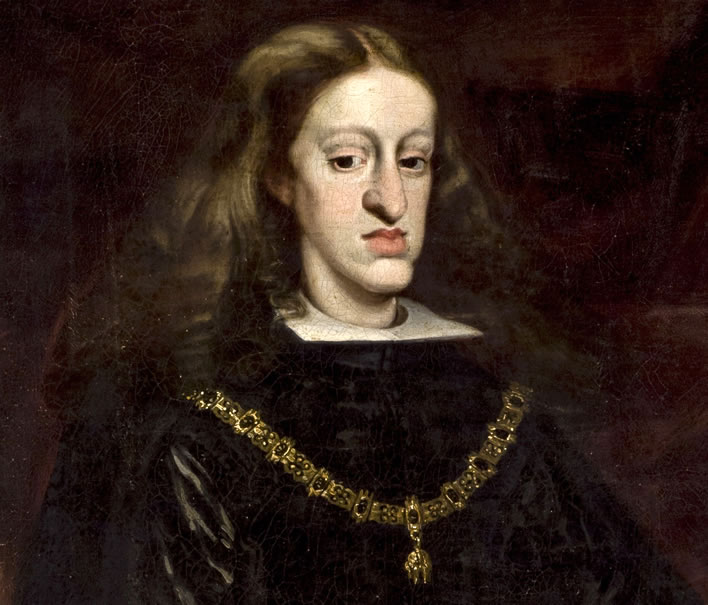
Carlos II in his full glory. The painter did the best he could with his sitter.
Juan Carreño de Miranda (1614-1685), Carlos II of Spain (1661-1700)(detail), c. 1685. Kunsthistorisches Museum, Vienna.

Carlos II in even fuller glory. Wigs have their limitations.
Paul Strudel (1648-1708), Bust of Carlos II of Spain (1661-1700), c. 1695. Kunsthistorisches Museum, Vienna.
He ascended to the throne when he was three, but didn't learn to speak until he was four. Even then, what he did say was largely incomprehensible because of his deformed jaw. He finally learned to walk when he was eight. Chewing was a challenge. Lazy, apathetic, frequently ill, uneducated and usually unwashed – outstandingly smelly in a generally malodorous era – the period of his reign was a disaster for Spain: wars, the climax of the power of the Inquisition with public burnings, court intrigue and more wars. The one blessing, if we can call it that, is that Carlos failed to breed – except that, on his death, the lack of a successor caused yet another war.
Leopold I (1640-1705), Maria Theresia's grandfather, exhibited a huge Habsburg lip. Six of his immediate ancestors were themselves grandchildren or great-grandchildren of the same person, the deliciously named Johanna the Mad of Spain (the wife of Philip 'the Fair' (1478-1506)).

Emperor Leopold I.
Paul Strudel (1648-1708), Bust of Emperor Leopold I (1640-1705), c. 1695. Kunsthistorisches Museum, Vienna.
Genetic makeup cannot be abused in this way without consequences. Small and ugly, Leopold I was affectionately referred to by the Viennese as Fotzenpoidl, 'cunt[-face] Leopold'. The name was popular among his cheerful subjects and, long after his death, was still applied in particular to his grotesque likeness on the Plague Column (Pestsäule) in Vienna, a baroque monstrosity – no, let's be kind: a remarkable baroque monument – that Leopold had erected to mark the deliverance of the city from the great plague of 1679. Leopold's deliverance consisted in fleeing the city at the first sign of the outbreak, leaving the Holy Trinity – represented after the fact on the monument – to do what it could for the rest of the population. Some claim the unforgiving likeness of Leopold on the column is the revenge of the sculptor for an unpaid bill.
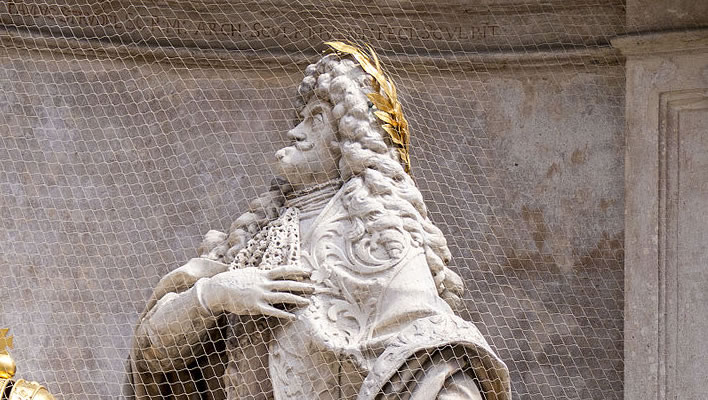
The Emperor Leopold I, Fotzenpoidl, on the Vienna Pestsäule.
However, unlike some other bearers of the Habsburg brand, he was intellectually extremely able. Modest, highly educated, accomplished and intelligent, he is now regarded by many historians as one of the saviours of the Empire and his dynasty in difficult times.
Unfortunately, the souvenirs of Leopold that remain in the mind are not his feats as a ruler but his likeness on the Plague Column and some remarkably honest paintings. Particularly ill-advised is a full-frontal painting of him in greasepaint and theatrical costume done in 1667: if you have a huge Habsburg lip, don't plaster bright red lipstick over it.
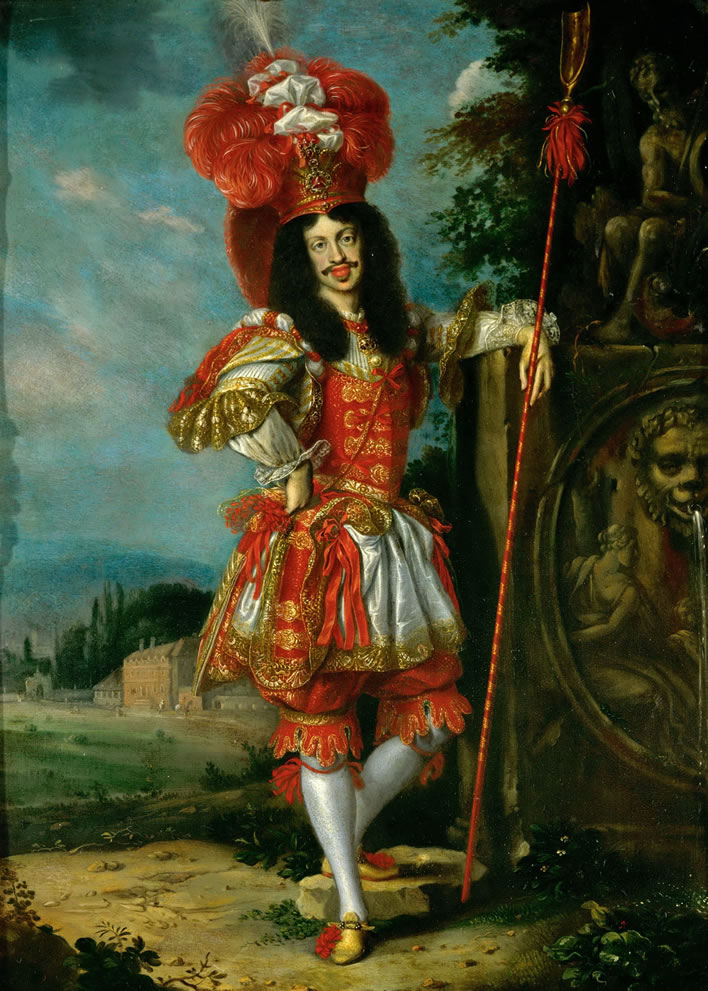
Emperor Leopold I ready for the stage. I wonder why his Viennese subjects called him Fotzenpoidl?
Jan Thomas (1617–1673), Emperor Leopold I in Theatre Costume (1640-1705), c. 1667. Kunsthistorisches Museum, Vienna.
He followed the family tradition and married a Spanish Habsburg princess, a fifteen year-old niece and cousin almost as belipped as he (see above: Margarita Teresa). He loved her deeply – perhaps seeing one's own image in someone else is the key in such matters. She died at 21 after four babies, three of whom were still born or died in infancy. The survivor was a girl and therefore not what was wanted at that precise moment.
His choice as his second wife was a second cousin, also substantially belipped, who bore him two babies who died in infancy. His wife died after barely three years of marriage. Finally, desperate to have a male heir – the fate of the entire dynasty was resting on this outcome by then – he married an unrelated German princess from the House of Wittelsbach – good breeding stock – who in the next 19 years produced ten children for him, most of whom survived. In them the Habsburg brand lip was less prominent but still present.
One of Leopold I's sons, Karl VI, his Habsburg genes now diluted by Wittelsbach genes, married a German princess from the House of Welf, who therefore also partially drained the Habsburg gene swamp. Their daughter, Maria Theresia (1717-1780), was therefore not only an Empress who rescued the dynasty's precarious political fortunes, she also rescued it genetically.
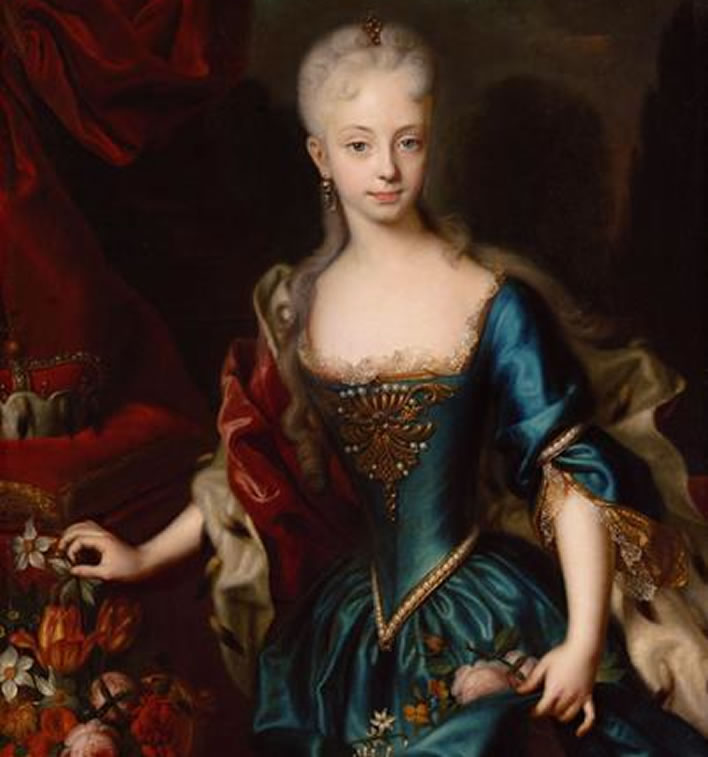
Empress Maria Theresia (1717-1780), eleven years old. The flowers and the fruit are symbols of fertility, here not at all out of place. Just as the Habsburgs were running out of heirs Maria Theresia produced sixteen babies in quick succession, only six of whom died in her lifetime. There is nothing more I can say about this painting without attracting the attention of the police.
Andreas Möller (1684–1762?), Empress Maria Theresia, eleven years old (1717-1780), c. 1727. Kunsthistorisches Museum, Vienna.
She lived a long and fecund life (16 children). She displays a trace of the Habsburg brand logo in her lip, but only enough to be noticed on careful inspection. She married Franz Stephan of Lorraine, also a Habsburg and also the possessor of a fine, but not disfiguring lower lip. When their Habsburg lips touched, his own Habsburg genes were added to the alliance and their numerous children all display the brand logo to some extent. Their offspring carried their Habsburg traits forward, even compounding the problem by themselves marrying within the Habsburg bloodline.
After Maria Theresia the descent followed through her son Leopold II. He and his wife, a Bourbon-Habsburg mixture, through their fecundity (16 children) assured the Habsburg succession for that generation. The political expediency of Habsburg intermarriage despite its genetic inadvisability remained, though. Leopold's second son, Ferdinand, initially baulked at his arranged bride, another Habsburg princess, asserting that she looked too much like his father. Ferdinand was being kind: even with the best efforts of the court painter she looks more like Carlos II of Spain in a dress.
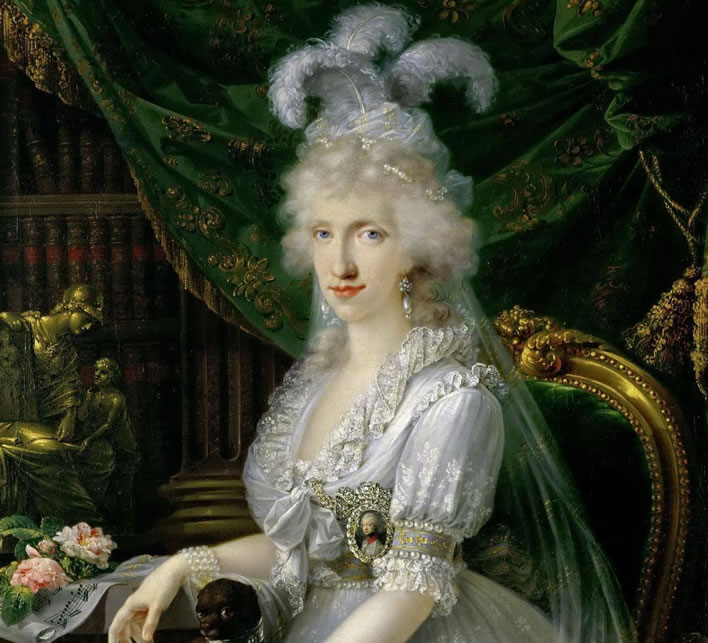
Luisa Maria Amelia Teresa (1773-1802), wife of Archduke Ferdinand III of Tuscany.
Joseph Dorffmeister (1764–1814), Luisa Maria Amelia Teresa of Naples and Sicily (1773-1802), c. 1797. Kunsthistorisches Museum, Vienna.
Leopold II's first son, Franz II/I, married a double cousin and produced a mentally and physically defective boy as their second child. Because of his many impediments the child was kept out of public view for several decades. Those impediments did not prevent his succeeding his father to become Emperor Ferdinand I of Austria – 'the Benign' – meaning, surely, that he was too simple to do any harm. Nevertheless, he was the figurehead of the Empire for 13 years until he had to abdicate in 1848, the year of the great revolutions in Europe.
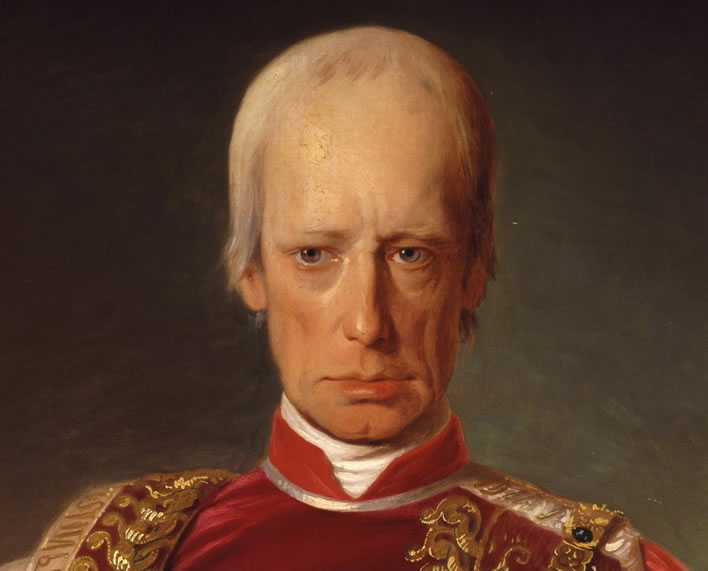
Franz II/I (1768-1835), still carrying the lip gene.
Friedrich von Amerling (1803-1887), Franz II/I in the robes of the Order of the Golden Fleece (1768-1835), c. 1832.
For dynasts, descent is everything and the lack of even ordinary mental and physical capacities is seemingly no bar to ascending the throne, particularly in later times when kings and emperors, unlike Rudolf I, the founder of the dynasty, had other people to do their fighting and their ruling for them.
References
- ^ For a scientific review of Habsburg inbreeding see: Alvarez G, Ceballos FC, Quinteiro C (2009), The Role of Inbreeding in the Extinction of a European Royal Dynasty. (free access), PLoS ONE 4(4): e5174. doi: 10.1371/journal.pone.0005174.
0 Comments UTC Loaded:
Input rules for comments: No HTML, no images. Comments can be nested to a depth of eight. Surround a long quotation with curly braces: {blockquote}. Well-formed URLs will be rendered as links automatically. Do not click on links unless you are confident that they are safe. You have been warned!